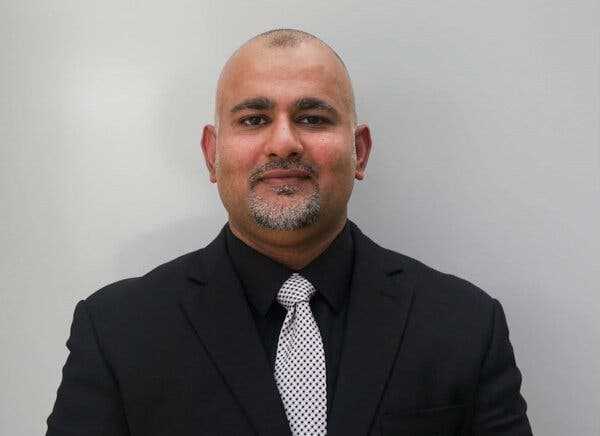Majid Khan, a Pakistani citizen who attended high school in Maryland, finished his sentence last year.
-
Send any friend a story
As a subscriber, you have 10 gift articles to give each month. Anyone can read what you share.
Give this articleGive this articleGive this article

Majid Shoukat Khan, seen in this 2022 image provided by his lawyers, was held in a secret C.I.A. prison before being taken to Guantánamo Bay.

By Carol Rosenberg
Feb. 2, 2023, 10:30 a.m. ET
BELIZE CITY — A small Central American nation, known for its barrier reef and ecotourism, has taken in a former terrorist turned U.S. government informant whose tale of torture by the C.I.A. moved a military jury at Guantánamo Bay to urge the Pentagon to grant him leniency.
U.S. forces released Majid Shoukat Khan, 42, to the custody of the authorities in Belize after a two-hour flight from the U.S. Navy base in Cuba.
It was the first resettlement of a detainee since President Barack Obama’s administration and culminated months of secret diplomacy. All other prisoners released in the intervening years were repatriated. But Mr. Khan, who completed his prison sentence nearly a year ago, had nowhere to go.
“I have been given a second chance in life, and I intend to make the most of it,” Mr. Khan said in a statement in which he pledged to become “a productive, law-abiding member of society.”
“I continue to ask for forgiveness from God and those I have hurt,” he said.
The circumstances of his resettlement were not immediately known. But he was expected to be joined by his wife and teenage daughter, who was born after his capture in Pakistan in 2003.
Mr. Khan was among the better-known prisoners of Guantánamo Bay, in part because he went to high school in Maryland, then left his immigrant family for his native Pakistan to join Al Qaeda after the attacks of Sept. 11, 2001.
From 2003 to 2006, he was held incommunicado in secret C.I.A. prisons overseas and kept in dungeonlike conditions that included beatings, nudity, brutal forced feedings, waterboarding and other physical and sexual abuse.
The Secretive World of Guantánamo Bay
- The Docket: Since 2002, roughly 780 detainees have been held at the American military prison in Cuba. Now, a few dozen remain.
- Landmark Cases: Three former Guantánamo prisoners who won Supreme Court cases that have shaped the military’s ability to detain men at the prison are today ensconced in family life. We caught up with two of them.
- A High Price Tag: There are only a handful of detainees at Guantánamo, and it costs $13 million a year per prisoner to keep them there.
- First Photos: After 20 years of secrecy, The Times obtained secret Pentagon photos of the first prisoners brought to Guantánamo Bay.
- A Look Inside: In 2019, our reporter and photographer took a four-day tour of the base and its prison. Here’s what they saw.
In 2012, he agreed to testify against other prisoners. He also pleaded guilty to plotting a never-realized suicide bombing years earlier of Pakistan’s president at the time, Pervez Musharraf, and to delivering $50,000 that was used to finance a deadly attack in Indonesia.
His release in Belize was noteworthy for several reasons.
He was the first prisoner to be freed from Guantánamo Bay who had been held there as a “high-value detainee,” the intelligence community’s term for a former prisoner of a C.I.A. black site who was subjected to the Bush administration’s secret torture program of “enhanced interrogation.”
A damning 2014 Senate investigation of the covert program disclosed what the C.I.A. did to Mr. Khan when he went on a hunger strike in his second year of detention: His captors “infused” a purée of pasta, sauce, nuts, raisins and hummus into his rectum. His lawyers called it rape.
At his sentencing in 2021, Mr. Khan expressed remorse for his crimes and related his story to a U.S. military jury at Guantánamo, which followed war court guidelines and sentenced him retroactively to 26 years in prison. Seven of the jurors then urged granting him clemency.
What we consider before using anonymous sources. Do the sources know the information? What’s their motivation for telling us? Have they proved reliable in the past? Can we corroborate the information? Even with these questions satisfied, The Times uses anonymous sources as a last resort. The reporter and at least one editor know the identity of the source.
Learn more about our process.
“This abuse was of no practical value in terms of intelligence, or any other tangible benefit to U.S. interests,” they said in a handwritten letter from the jury room. “Instead, it is a stain on the moral fiber of America; the treatment of Mr. Khan in the hands of U.S. personnel should be a source of shame for the U.S. government.”
A U.S. official, who spoke on the condition of anonymity because of diplomatic sensitivities, said Belize’s government received Mr. Khan as a humanitarian act, to help him seek a fresh start. Details of the resettlement deal were not disclosed, but officials have described similar arrangements as a host country essentially granting a detainee asylum.
The transfer agreement was reached last year in talks between senior Belize government officials and Ian C. Moss, a lawyer who had helped defend Mr. Khan at Guantánamo Bay during the Trump administration, and then was appointed as a deputy counterterrorism coordinator at the State Department, the official said.
Eamon Courtenay, Belize’s foreign minister, visited the prison on Oct. 14 to meet with Mr. Khan and evaluate his suitability for life in the English-speaking nation of about 400,000 citizens, among them fewer than a thousand Muslims.
“This resettlement required considerable diplomatic creativity and perseverance,” said Lee S. Wolosky, who served as special envoy for the closure of the Guantánamo prison during the Obama administration. Mr. Moss was his chief of staff.
The case had been of interest to the international law and human rights community in part because, even though Mr. Khan’s sentence had ended, he was imprisoned in the same razor-wire ringed compound at Guantánamo for nearly a year. His lawyers asked a federal court in a habeas corpus petition to order his release onto the base until a country could be found for him.
Mr. Moss said in a court filing this summer that diplomats had approached 11 countries in an urgent effort to find a place for Mr. Khan.
“We are thrilled that Majid is free,” J. Wells Dixon of the Center for Constitutional Rights, said in a statement. He has represented Mr. Khan in federal and military courts since his arrival at Guantánamo in 2006.
Katya Jestin, a lawyer at Jenner & Block, who joined the case pro bono in 2009, called his release “a historic victory for human rights and the rule of law, but one that took far too long to reach.”
With this week’s transfer, the Pentagon now holds 34 prisoners at the Guantánamo Bay detention facility. Of them, 11 have been charged in the military commissions, including six who are awaiting capital trials. Three others, all former C.I.A. prisoners, are being held as indefinite detainees in the war on terrorism — not accused of any crimes but considered too dangerous to release.
The other 20 men, half of them Yemenis, have been approved for transfer to other countries with security agreements that satisfy the secretary of defense, arrangements that have required far more complex diplomacy and at times unknown enticements by the United States.
The Biden administration has repatriated five cleared prisoners, and the Trump administration sent one man to serve a sentence in his native Saudi Arabia. But the last resettlement occurred in the final days of the Obama administration, when Oman accepted eight Yemenis and two Afghan prisoners who could not safely be returned to their home countries.
Belize is the nearest nation to Guantánamo that has received a prisoner. Obama-era envoys arranged settlements in Bermuda, El Salvador and Uruguay. But most have been in Europe and the Middle East, and a few in Africa.
Source: nytimes.com



